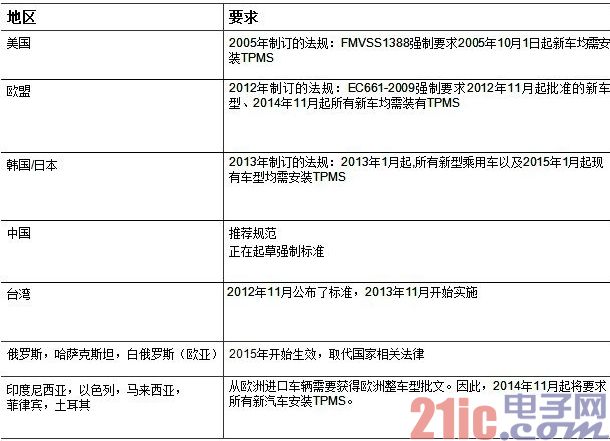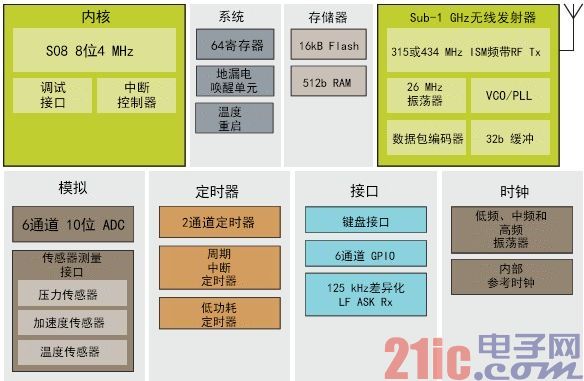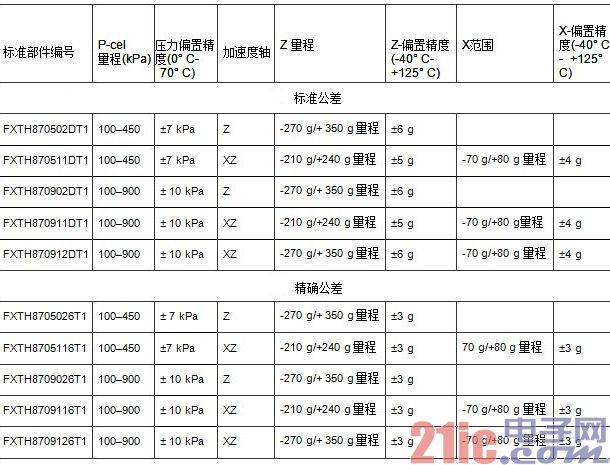Summary This article refers to the address: http:// Tires are the basis for comfort, safety and fuel-efficient driving – provided that the inflation is moderate. This may seem simple, but without the tire pressure monitoring system (TPMS), the driver can only take it for granted, and usually can't get the right tire pressure. Let's take a look at the regulations of governments around the world. Basically, each region uses proven technology to efficiently monitor tire pressure, alert drivers to possible hazards, and introduce regulations that require automakers to equip TPMS in many categories of vehicles. introduction Based on pressure sensing, microcontroller (MCU), radio frequency (RF) and interface technologies required for TPMS, Freescale Semiconductor has been actively involved in tire pressure monitoring for more than 15 years. In 2007, Freescale has not only continued to provide separate components, but also integrated its technology into a single package solution. Recently, Freescale's technology has made new progress, providing an updated single-package solution that leverages advances in microelectromechanical systems (MEMS) and MCU technologies to extend the performance of this integrated solution. This article describes the requirements of the tire pressure monitoring system and the changes to implement the system, as well as the latest technology for system-level packaging solutions, and discusses the technological advances that may occur in the near future. Good driving Proper tire pressure is not just about making the tire pressure reach the manufacturer's recommended range. In some cases, it may cause trouble to the driver. First, the pressure recommended by the manufacturer is a "cold" pressure. The tire pressure is measured after the vehicle is stopped for more than one hour. The measured tire pressure is determined by the load capacity of the tire, and the tire pressure is increased during driving. When the tire gets hot due to driving, the tire pressure measurement should not be lowered to estimate the cold tire pressure, and most tire tire pressures typically increase by about 3-5 psi (20 kPa to 35 kPa) per square inch while driving. The tire pressure gauge usually measures the difference between the external environmental pressure and the internal pressure of the tire (called gauge pressure). However, the tire pressure is affected by changes in altitude. For example, at high altitudes (such as Flagstaff, Ariz.), when a car with the right tire pressure is driving to a lower altitude (such as Phoenix, Arizona), there will be insufficient air pressure, about 3 psi less (20 kPa). ). Similarly, the pressure on the tires in Phoenix's cold tires will be too high when driving to Flagstaff, about 3 psi (20 kPa). Seasonal temperature changes are also factors that affect tire pressure. Even if you do not consider the loss of air pressure due to tires that have not been working for a long time (see Safety Considerations), setting the cold air pressure in summer (for example, about 90 °F, about 32 °C) will also be 0 °F (about 0 °F). The winter morning setting of -18 °C) is reduced by approximately 16%. Without TPMS, drivers who do not check the tires often or in some cases may use tires with abnormal air pressure and are therefore at risk of driving. Recap history According to the National Highway Traffic Safety Administration (NHTSA), there are 23,000 traffic accidents involving tire leaks or punctures every year without TPMS, of which 535 are fatal. These two problems may be caused by improper tire pressure. For security reasons, the US government has enacted the Transport Equipment Recall, Improvement, Liability Determination and Documentation Act (TREAD). As part of the TREAD Act, the Federal Motor Vehicle Safety Standard (FMVSS 138) requires that all cars, trucks, and buses with a total weight rating of 10,000 pounds or small quantities must be installed with TPMS since 2008. The rest of the world is also aware of the safety problems caused by abnormal tire pressure. In France, Sécurité Routière estimates that 9% of traffic fatalities are caused by insufficient tire pressure. Germany's DEKRA estimates that tire-related problems account for approximately 41% of all traffic accidents and points out that without TPMS, 75% of vehicles on the road have at least one tire with a deficit of 3 psi (20 kPa) or more. In addition to improving safety, tires with suitable air pressure can improve the fuel economy of the vehicle. Therefore, TPMS has been requested or will be required in many regions. Table 1 shows the requirements and implementation times for different regions. Table 1. TPMS regulatory requirements by region The promulgation of regulations has driven significant growth in TPMS. Market research firm Frost and Sullivan predicts that by 2014, nearly 38% of vehicles in North America will install TPMS. The company expects the number of in-service vehicles installed in Europe to increase to 36.7 million by 2018. The implementation of TPMS regulations makes tire pressure an important part of automotive stress testing (including manifold absolute pressure (MAP), atmospheric absolute pressure (BAP), airbag pressure, brake pressure, HVAC pressure, etc.). According to IHS iSuppli estimates (Figure 1), by 2015 2TPMS will account for more than 25% of the entire pressure measurement market for automotive sensors. Figure 1. Total growth of TPMS and automotive pressure sensors. Source: IHS iSuppli Automotive MEMS Market Tracking Safety considerations Tires with suitable air pressure can reduce the number of tires, shorten the braking distance, reduce the slippage of wet roads, and improve the overall maneuverability of the vehicle. For TPMS, the primary task of testing is to prevent punctures. Tires with insufficient air pressure heat up faster and cannot carry the load they specify. This can cause the tire to bend excessively, causing the tread to separate and puncture. If the tire is not affected by road damage, its monthly natural air leak is 1 psi (6.9 kPa), and 85% of the tire pressure loss is caused by slow air leakage. Insufficient air pressure plus high speed and/or overload conditions increases the risk of tire puncture. This catastrophic event may cause the vehicle to suddenly rush to an oncoming vehicle or lose control. Even if the driver controls the vehicle, the tire needs to be replaced urgently. Changing tires in the driveway usually puts the driver at risk of rapid traffic, especially at night or in bad weather. In extreme cases where the tire pressure exceeds the rated maximum, it is necessary to worry about excessive air pressure. Excessive air pressure may be caused by a combination of excessive tire inflation and subsequent heating due to driving and sun exposure. Because these conditions are rare, most TPMS do not alert you to excessive air pressure. However, some systems still issue an alarm for excessive air pressure. Fuel economy considerations In addition to the safety of the tire pressure, there are certainly economic considerations. European standards consider the fuel economy provided by normal tire pressure. However, abnormal tire wear due to increased tire wear and improper air pressure also increases the driver's cost of ownership. The commercial freight industry relies on high fuel economy to reduce costs and proves that tire pressure is normal and economically beneficial. Tests conducted by Goodyear Tire & Rubber showed that 15% of the tires of the car and trailer tires were insufficient, resulting in a 8% reduction in tire life expectancy and a 2.5% reduction in fuel efficiency. Since heavy tractors/trailers may have more than 18 tires, each vehicle can save thousands of dollars in fuel costs and tire repair costs over its lifetime of hundreds of thousands of miles if the tire pressure is maintained. Passenger cars can also get these two benefits due to normal tire pressure. Direct and indirect tire pressure monitoring systems Motor vehicles use two types of tire pressure monitoring technologies - direct monitoring and indirect monitoring. The indirect TPMS uses a speed sensor in an anti-lock braking system (ABS) to compare the difference in rotational speed between the tires to determine the underpressure condition. Because when a tire's air pressure is insufficient, its radius will be slightly smaller than the normal tire pressure, so the speed of the tire is different from the normal tire speed when the car is running. When the system detects an insufficient air pressure, it will alert the driver. The main disadvantage of the indirect system is that it does not detect a slow leak in all tires due to air penetrating rubber or a slight air leak at the edge of the sidewall rim or the valve. If all tires have substantially the same air leak rate, there will be no significant change in the speed between the tires. Therefore, indirect systems are not useful for "monitoring" tire pressure. However, for unexpected leaks such as piercing and puncture, its monitoring effect is still quite good. In addition to requiring the vehicle to be in a driving state, indirect systems generally do not provide the same results as direct systems. Moreover, if the tire is replaced, exchanged, or recharged, the user must reset the system each time. In contrast to indirect systems, direct TPMS uses a pressure sensor mounted on the nozzle or rim or in the tire to provide independent, frequent air pressure measurements for each tire. These measurements are transmitted to the car dashboard to inform the driver. Since FMVSS 138 allows a tire to lose 25% of its time, the reminder time can be delayed by up to 20 minutes, so some systems may delay a few minutes of reporting when the tire pressure is insufficient. TPMS system designers use this rule to minimize data transfer to extend battery life. Indirect TPMS has some difficulties to pass European and other standards, as reflected in the market outlook report of the market research firm Strategy Analytics3. According to Ian Riches, director of automotive electronics services at Strategy Analytics, global legislation has been a challenge for indirect systems, consuming its cost advantage. “What we are seeing now is that the market share of direct and indirect methods is about seven or three.†He said, “By 2020, we expect more than 80% of the globally produced light vehicles to be equipped with TPMS. Global ownership of direct systems. The rate will be around 57% and the indirect system will be about 24%." Freescale's direct tire pressure monitoring system In 2007, Freescale pioneered the MPXY8300 direct tire pressure monitoring single-chip solution, reducing the processing of multiple devices and the size of printed circuit boards. TPMS suppliers do not need to add additional device costs. The small size gives the supplier the opportunity to use a solution for all models with different rim sizes. The FXTH87 TPMS series is part of the Xtrinsic portfolio of highly integrated sensing solutions and takes this design approach to the next level. The latest single package design includes: ◠Pressure sensor ◠Temperature sensor ◠Acceleration sensor ◠MCU ◠Radio frequency (RF) transmitter ◠Low frequency receiver (LFR) ◠Software The sensing capabilities of the FXTH87 TPMS come from: ◠Capacitive pressure sensor with one calibrated pressure range (two in total) ◠Temperature sensor ◠Optional X-axis and Z-axis accelerometers Figure 2 shows the CMOS surface micromechanical pressure sensing pressure unit 1 and XZ, biaxial acceleration sensor or acceleration unit in the FXTH87 TPMS. Figure 3 shows the basic aspects of a package-level TPMS solution. Figure 3. The basic aspects of a TPMS solution include sensing, processing, data transfer, and power management techniques. The TPMS consumes 7 mA at 434 MHz @ 5 dBm (dBmW), 7 mA at @5dBm, and 900 nA in Stop mode. Multiple stop modes give programmers a variety of options to achieve the best balance of performance and power consumption. The 0.25 micron MCU integrates low frequency (LF) and radio frequency (RF) communication technologies. When receiving low frequency signals for short-range communication in a TPMS, the power consumption of the LFR is extremely low. The FXTH87 TPMS's built-in 315/434 MHz RF transmitter includes a radio frequency module (RFM) with crystal oscillator circuit, voltage controlled oscillator (VCO), a fractal-n phase-locked loop (PLL) and an RF output amplifier for the antenna (PA) ). It also includes a small state machine controller, a random time generator and a hardware data buffer for automatic output or direct control by the MCU. The entire system block diagram shown in Figure 4 identifies other system aspects, including analog-to-digital conversion (ADC), sensor interfaces, RF amplification, and various timers and memory modules. The low-power surface micromechanical capacitive pressure sensor's pressure unit provides accurate pressure measurement up to 1500 kPa (up to 217 psi). The FXTH87 TPMS is now available in pressure ranges from 100–450 kPa (up to 65 psi) and 100-900 kPa (up to 130 psi), covering everything from small passenger cars to high-performance cars and large sport utility vehicles (SUVs). . Figure 4. The FXTH87 block diagram shows the various system level modules of the TPMS. Capacitive pressure sensors require only 0.14μA of current (3 V, 30 KHz) and a minimum charge of 0.9 nAs per read. As shown in Table 2, the FXTH87 combines with the accelerometer option to provide considerable TPMS design flexibility. Table 2. Orderable TPMS parts with acceleration sensor shaft and pressure range As shown in Figure 5, a 24-pin, 1-hole 7×7 QFN (quad flat no-lead) package is commonly used in FXTH87 TPMS products. This system-in-package solution reduces board size, potting material and weight. Figure 5. Standard TPMS package including 7 x 7 mm QFN specifications Continual progress/changes in TPMS Active industry research and other technological advances as well as new regulations are expected to change the functional requirements of future TPMS systems. Displaying more information about vehicle health, especially when it comes to tires, will require automakers to acquire and transmit data more frequently. Energy harvesting, dual-axis accelerometers, airless tires, and regulatory modifications, such as extended frequency ranges, are under discussion. First-tier system manufacturers have introduced products that integrate TPMS with other vehicle systems. The vehicle stability control system can take advantage of the additional information provided by the TPMS. Stabilization control requires sensor fusion to combine TPMS data with data from other vehicle sensors. Freescale's sensor fusion capabilities provide raw data in the right format for use in other vehicle systems. Energy harvesting technology extracts electrical energy from the vibrations of the tires, eliminating the need to replace batteries that supply power to the TPMS nodes of each tire, or significantly extending battery life. Energy harvesting can support the advancement of other TPMS. Today, TPMS data is transmitted at very slow, long-term intervals and is only used to determine if the tire pressure is reduced. Integrating tire pressure data into stability control requires more data and more frequent transmission, which greatly reduces battery life in existing designs. With energy harvesting, higher data rates are achieved without the need to change batteries frequently. Freescale is exploring the implementation of emerging energy harvesting technologies in TPMS. Dual-axis accelerometers and three-axis accelerometers are commonly used in consumer electronics for motion detection. However, most tire pressure monitoring systems today use a single acceleration unit. With a two-axis accelerometer, the TPMS manufacturer can identify the position of the tire, a process known as positioning. Some TPMS manufacturers may require a three-axis function. For example, China's TPMS regulations may require that tires be tracked during a flameout to determine if the tire has changed as a result of a shift or a problem changing from one location to another. Today, when performing specific tire positioning, the vehicle needs to be in a driving state so that the system can investigate the data for each tire and then determine the position of each tire. The use of a two-axis accelerometer satisfies almost all positioning schemes, while a single-axis accelerometer is limited by its application. Airless tires can greatly interfere with the installation of the TPMS. Tire manufacturers are working hard to develop airless tires that may begin to appear in production vehicles for the next five to ten years. However, before the popularity of airless tires, automakers will still have to rely on TPMS technology to maintain the normal air pressure of pneumatic tires. Airless tires also require a tire monitoring system that needs to detect the pressure and load applied to the tire. Regulations are being revised, as it is now proposed to use higher frequencies than the crowded 434 MHz in Industrial, Scientific and Medical (ISM). Mainland China or Taiwan may change to 835-875 MHz. When the new frequency is established, Freescale will have a transmitter that uses the new frequency band. Freescale has been working with automotive market leaders to develop TPMS applications and continually explore the use of system-level packaging technology to enable TPMS suppliers to effectively control costs and design time. Driving safer and more efficient Tire pressure monitoring systems have proven to help improve vehicle safety and fuel economy, thereby reducing CO2 emissions. These systems also reduce tire wear, make tires last longer, and provide consistent driving quality. Because of the many benefits, the government does not need regulations to provide value to car buyers. However, regulations exist and are increasing all over the world. The introduction of regulations has brought additional development momentum, provided predictable market growth, and promoted fierce competition among TPMS suppliers. In 2003, Freescale pioneered the original TPMS system-level single-chip solution. Xtrinsic FXTH87 has recently achieved the latest results, bringing TPMS design to a new stage. The pressure range, accelerometer shaft, package and other options make the FXTH87 TPMS an easy-to-design solution that meets even the most complex TPMS requirements in the world today. The automotive market is a key business area for Freescale, and TPMS expertise is not limited to system-level expert discussions with customers, but the ability to integrate all relevant technologies into a single package. This not only makes full use of the experience advantages of the chip field in many fields, but also our software experience in the development and exploration of several other fields (including sensor fusion). The final conclusion is that the highly integrated Xtrinsic system solution is fully validated in the tire pressure monitoring system. September Weekly deals,High Quality September Weekly deals,September Weekly deals Details, CN ZHONGSHAN G-LIGHTS LIGHTING CO., LTD. , https://www.glightsled.com





